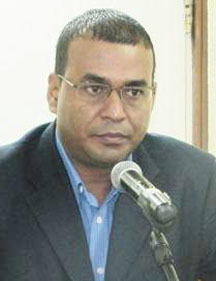Confronted for the first time in almost two years with a sudden, sharp downward movement in gold prices, local stakeholders, the government, investors as well as the hundreds of employees ranging from skilled workers to labourers can do no more than keep their fingers crossed for the survival of what, up until now, has been a lucrative love affair with the precious metal.
Last week, as prices dipped amidst Europe’s preoccupation with trying to put Cyprus’ broken economy back together again, Natural Resources Minister Robert Persaud convened a meeting with the stakeholders. By their own admission, however, the state officials and investors appear to have long conceded that they can do little more than wait it out in the hope that the recent slip in prices does not move into a condition of free fall.
Earlier in the week, the sobering point was made that Guyana, like every gold-producing developing country is a passive “price-taker,” another way of saying that the local mining sector really has little option but to grin and bear it.

Crisis may not – at least at this stage – be the appropriate word to describe the state of affairs in the sector. On the other hand, the assurance offered by Guyana Gold and Diamond Miners Association (GGDMA) President Pat Harding just prior to the stakeholder meeting that the industry was not about to go into a state of panic will not hold good forever. If gold prices continue to fall those operators at the lower end of the food chain could lose their nerve. These could include small and medium-scale operators. This would affect the thousands of other service providers in other sectors and families whose jobs and livelihoods depend on gold.
A five per cent drop in gold prices on the world market on Friday was followed on Monday by a further price dip, the two downward adjustments pushing the gold price to US$1,400 per ounce. Cumulatively, the two price reductions resulted in an overall decline of 9.35 per cent, the worst one-day percentage decline in gold prices in 30 years. In effect, gold, commonly viewed as a hedge against inflation in tough times is now down by more than US$500 from its all-time high of US$ 1,888.70 in August 2011.
From Guyana’s standpoint, the significance of falling gold prices is readily apparent. For almost a decade, the gold industry has played an increasingly significant role in the shaping of the Guyana economy. While the major investors in the industry and the government – through the collection of royalties – have reaped most of the benefits of rising gold prices, the industry has also – directly and indirectly – played a significant role in the livelihoods of several thousand Guyanese families. Though the gold industry is located in the interior of Guyana it is directly responsible for ensuring the protection of jobs in food, transportation, and equipment supply and servicing and several other coastal business enterprises. The past few years have witnessed an accelerated shift of unemployed and underemployed men and women from coastal areas to the goldfields of the hinterland. The shift has been sufficiently significant to result in complaints from other sections of the economy about a loss of skills – chiefly heavy-duty machine operators, mechanics and drivers – to the gold industry.
In effect, much of the country’s economy is now shaped entirely by high gold prices. Sustained and significant price falls will damage, if not disfigure altogether, businesses that have been built on the back of the gold industry. Significant numbers of livelihoods will be lost in an economy where alternative livelihoods will not be easy to find.
At the conclusion of the meeting, which was attended by officials of the state-run Guyana Geology and Mines Commission (GGMC) the Guyana Gold Board and the GGDMA, a statement was issued, in which it pointed out that gold prices had been “marginally declining” since the beginning of 2013. The statement alluded to “the effects of the Cyprus bail out” including “the selling of reserve gold” by its central bank and the likely knock-on effect of further gold sales by European central banks coupled with a likely drop in gold purchases by China on the back of the current slowing down of the country’s economy as being among the key reasons for the recent sharp fall in gold prices. That apart, however, the meeting appeared able to do little more to allay fears that further slippage in gold prices could hit the Guyana economy hard. In fact, the GGDMA has already gone on record as saying that “the global price of gold will affect the level of output, investment and earnings of Guyana.”

To ensure that the impact of the price change “is not significantly felt by Guyana,” the GGDMA said, the meeting agreed on “a few short term measures which include the application of better technology for recovery and production, more effective tax breaks and duty-free concessions for miners and improved methods of building local machinery for miners.” The meeting also agreed that there was a need for unspecified “diversification of mineral extraction activities,” the introduction of “a revolving fund for new technologies to be contributed to by both the state and the miners and improved administrative methods for the processing of mining permits.” The statement said the miners want government to help battle the fall in gold prices by reducing operating costs through the improvement of roads and other infrastructural requisites in mining areas.
In the final analysis, however, the powerlessness of the local players in the mining sector to do anything meaningful to stave off the effects of falling gold prices on the industry and the economy as a whole was reflected in the decision by the meeting to set up a “working group” comprising representatives of the state and private sector stakeholder bodies which will simply continue “monitor the situation”.





